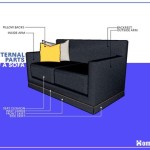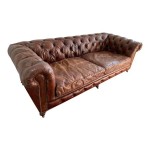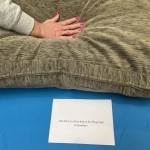Can I Recover A Leather Sofa With Fabric? A Comprehensive Guide
The question of whether a leather sofa can be recovered with fabric is a common one among homeowners seeking to update their furniture without the expense of purchasing a new piece. The answer, in short, is yes, a leather sofa can be recovered with fabric. However, the process involves several considerations, potential challenges, and a significant commitment to time and resources. This article will explore the key aspects of recovering a leather sofa with fabric, outlining the factors to consider, the steps involved, and the potential benefits and drawbacks of undertaking such a project.
Recovering furniture, in general, is a practice that offers a sustainable approach to home decor. Rather than discarding a perfectly functional piece of furniture simply because its aesthetic no longer aligns with current preferences, recovering allows for customization and a fresh look. While traditionally, furniture recovery might involve replacing worn-out fabric with a similar material, the option of transitioning from leather to fabric opens up a broader range of design possibilities. This process is particularly appealing to individuals who appreciate the inherent quality and structural integrity of their existing sofa frame but desire a change in its overall appearance and feel.
Before embarking on this project, it is crucial to thoroughly assess the condition of the leather sofa. Examine the frame for any signs of damage, such as cracks, loose joints, or wood rot. Also, evaluate the condition of the cushions, springs, and webbing system. Addressing any underlying structural issues before applying new fabric is essential to ensuring the longevity and comfort of the recovered sofa. Neglecting these repairs could result in the new fabric showing signs of wear and tear prematurely or, worse, a collapse of the sofa's support structure.
Key Point 1: Assessing the Feasibility and Preparing the Sofa
The feasibility of recovering a leather sofa with fabric hinges on several factors, including the sofa's construction, the desired aesthetic, and the available budget. A critical step is determining whether the existing leather upholstery can be effectively removed. Some leather sofas are constructed with the leather glued directly to the frame, making removal challenging and potentially damaging to the underlying structure. In such cases, the new fabric may need to be applied over the existing leather, which could impact the final appearance and feel of the sofa.
If the leather can be removed, proceed carefully to avoid damaging the frame or any internal components. Use appropriate tools, such as seam rippers and pliers, to detach the leather from the frame. Once the leather is removed, thoroughly clean the sofa frame to remove any residual adhesive, dirt, or debris. This ensures a clean surface for the new fabric to adhere to properly. Filling any imperfections in the frame with wood filler and sanding it smooth will further improve the final result.
Taking precise measurements of each section of the sofa is crucial for accurate fabric cutting. Disassemble the existing leather upholstery and use it as a template to create accurate patterns for the new fabric pieces. Add seam allowances to each pattern piece to allow for proper stitching and attachment. This meticulous approach will minimize errors and ensure a professional-looking result. Label each pattern piece clearly to avoid confusion during the cutting and sewing process.
Consider removing the existing cushions from the sofa. If the cushions are still in good condition, they can be reused. However, if they are worn, lumpy, or sagging, replacing them with new foam or fiberfill is recommended. This will significantly improve the comfort and appearance of the recovered sofa. Choose cushion filling materials that are appropriate for the desired level of firmness and support.
Key Point 2: Selecting the Right Fabric and Tools
Choosing the right fabric is paramount to the success of the project. Consider factors such as durability, stain resistance, texture, and overall aesthetic appeal. Opt for upholstery-grade fabrics that are specifically designed for high-traffic areas and frequent use. These fabrics are typically more resistant to wear and tear, fading, and pilling. Consider the color scheme and design of the room where the sofa will be placed when selecting the fabric pattern and color.
Several fabric types are suitable for recovering a leather sofa, including cotton blends, linen, velvet, and microfiber. Cotton blends offer a balance of durability and affordability. Linen provides a natural, textured look but may be more prone to wrinkling. Velvet adds a touch of luxury and sophistication but requires careful maintenance. Microfiber is highly durable, stain-resistant, and easy to clean, making it an excellent choice for households with children or pets. Obtain fabric samples to assess the texture and color in the actual lighting conditions of the room before making a final decision.
In addition to selecting the fabric, gathering the necessary tools is essential. A heavy-duty sewing machine capable of handling upholstery-grade fabrics is a must. Other essential tools include: fabric scissors, seam ripper, measuring tape, pins, chalk or fabric marker, staple gun, staples, pliers, and a hammer. A well-equipped workspace will streamline the recovery process and minimize frustration.
It is also important to consider the type of thread used for sewing the fabric. Choose a strong, durable thread that is specifically designed for upholstery. Polyester or nylon thread is generally recommended for its strength and resistance to abrasion. Select a thread color that closely matches the fabric to ensure a seamless appearance. Test the thread on a scrap piece of fabric to ensure that it does not snag or break easily.
Key Point 3: The Upholstery Process and Potential Challenges
The process of upholstering a sofa is meticulous and time-consuming, requiring patience and attention to detail. Begin by cutting the fabric pieces according to the patterns created earlier. Ensure that the fabric patterns are aligned correctly and that the fabric is smooth and free of wrinkles before cutting. Leave ample seam allowances to allow for adjustments and corrections during the sewing process.
Sew the fabric pieces together, following the original seam lines of the leather upholstery. Use a consistent stitch length and tension to ensure a strong and durable seam. Reinforce stress points with extra stitching to prevent tearing. Regularly check the fit of the fabric on the sofa frame to ensure that it aligns properly and that there are no gaps or wrinkles. Make adjustments as needed before proceeding to the next step.
Once the fabric cover is sewn together, it is time to attach it to the sofa frame. Use a staple gun to secure the fabric to the frame, starting at the center and working outwards. Pull the fabric taut and smooth as you staple to avoid wrinkles and sagging. Use pliers to remove any staples that are not properly secured. Trim any excess fabric and tuck it neatly under the frame. Pay close attention to corners and curves, ensuring that the fabric is properly aligned and secured.
One of the primary challenges in recovering a leather sofa is dealing with the bulkiness of the leather and the potential for the new fabric to slip or bunch. To address this, consider using a thin layer of batting or foam padding between the leather and the new fabric. This will provide a smoother surface and prevent the fabric from sliding. Applying a fabric adhesive spray to the leather before attaching the fabric can also help to improve adhesion. Dealing with intricate curves and corners requires patience and careful manipulation of the fabric. Use pins and clips to hold the fabric in place while you staple or sew it.
Recovering a leather sofa with fabric is a significant undertaking that requires careful planning, preparation, and execution. While it offers the opportunity to customize and refresh a piece of furniture, it also presents a number of challenges. By thoroughly assessing the sofa's condition, selecting the right fabric and tools, and following a meticulous upholstery process, it is possible to achieve a professional-looking result. However, it is important to acknowledge the time commitment and potential difficulties involved and to consider whether hiring a professional upholsterer might be a more practical option.

Recover Your Sofa From Leather To Fabric Stunning Transformation And A Lot Er Than New Rescot Upholstery

Change A Bonded Leather Sofa To Fabric Rescot Upholstery

Leather Sofa Repadding The Fast And Affordable Way To Give New Life Your Rescot Upholstery

How To Reupholster Leather Sofa With Severe Ling Of Surface Hometalk

Bringing Furniture Back To Life With This Sofa Reupholstery

Hamilton Leather And Fabric Sofa Re Upholstery Rescot

Is It Worth To Reupholster A Sofa Seatup Llc

Do It Yourself Divas Diy Strip Fabric From A Couch And Reupholster

Cost To Reupholster A Couch Save By Recovering We Can Fix That

How To Reupholster Leather Sofa With Severe Ling Of Surface Hometalk








